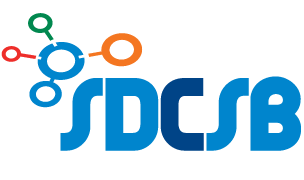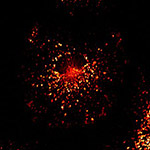Genetics, Bioinformatics and Systems Biology Colloquium
Thursdays, 12:00 pm – 1:00 pm
UC San Diego, Powell-Focht Bioengineering Hall, Fung Auditorium
Complete schedule here
While the dynamic control of NFκB dimer activity via the IκB-NFκB signalling module is well understood, there is little information on how specific dimer repertoires are generated from Rel family polypeptides. We built four computational models guided by in vitro and in vivo experiments to understand the positive and negative feedback loops controlled by the various IkB isoforms. Three of the models address how NFκB dimers are generated from RelA and p50 NFκB monomers and how interactions with two IκB isoforms may affect the abundance of these dimers. The fourth model addresses how nuclear localization of these NFκB dimers is induced and regulated following TNF-induced IKK activation.
Tsui R … Hoffmann A. Nat Commun. 6: 7068 (2015).
A new multi‐scale model predicts B‐cell population dynamics in terms of intracellular molecular networks. This model accounts for robust B‐cell population dynamics in terms of noisy molecular network dynamics in each cell. This multi‐scale model can predict how molecular perturbations and extrinsic noise effect cell population dynamics.
Shokhirev MN … Hoffmann A. Mol Syst Biol. 11: 783 (2015).
A model of TNF production taking into account nascent gene transcription, mRNA half-life stabilization and translation/secretion was connected with a model for TLR-induced IKK activation and IKK-induced NF-κB activation to produce a model for TLR-induced TNF production in the context of NFκB signaling. Iterative simulation and experimentation led to the inclusion of the TNFR model to allow for autocrine TNF signaling.
Caldwell AB … Hoffmann A. Genes Dev. 28: 2120-2133 (2014).
Network map of HIV-host interactions. Network propagation was used to smooth information in two networks of HIV-host interactions. One network was based on data from physical interactions (affinity–purification followed by mass spectrometry) and the other was from genetic interactions (three genome-wide RNAi screen). Smoothed networks were then combined into a single global map resulting in the identification of 40 HIV-human protein complexes involved in transcriptional control, translation, transport, and posttranslational modification, most of which have not yet been associated with HIV infection.
Emig-Agius D … Ideker T. PLoS One. 9: e96687 (2014).
A differential genetic interaction map was generated using growth measurements of over 45,000 Saccharomyces cerevisiae double mutants before and after UV radiation. Integrating this genetic data with networks of physical interactions resulted in a global map of 89 UV-induced functional interactions and 62 protein complexes, including a number of links between the remodel the structure of chromatin (RSC) complex and several nucleotide excision repair (NER) factors.
Srivas R … Ideker T. Cell Rep. 5:1714-1724 (2013).
A yeast regulatory network connecting checkpoint kinases and transcription factors was constructed by integrating kinase mutant expression profiles, transcriptional regulatory interactions and phosphoproteomics. This network revealed that Mec1 and Tel1 signal through Rad53 resulting in the activation of at least nine transcription factors and expression of over 600 genes.
Jaehnig EJ … Kolodner RD. Cell Rep. 4: 174-188 (2013).
The network-extracted ontology (NeXO) is a gene ontology inferred from large networks of gene and protein interactions in Saccharomyces cerevisiae. NeXO contains 4,123 biological terms and 5,766 term-term relations, capturing 58% of known cellular components. It is available both in Cytoscape Format and in Open Biomedical Ontology (OBO) Format.
Dutkowski J … Ideker T. Nat Biotechnol. 31: 38-45 (2013).
This paper reports a quantitative model that can accurately predict biological age from the genome-wide DNA methylation profile determined from a sample of whole blood.
Hannum G … Zhang K. Mol Cell. 49: 359-367 (2013).
A model of metabolism and macromolecular expression for the simple microorganism Thermotoga maritima. Models of metabolism and expression explicitly account for the genotype–phenotype relationship with biochemical representations of transcriptional and translational processes. This facilitates quantitative modelling of the relation between genome content, gene expression and cellular physiology. This model accurately simulates variations in cellular composition and gene expression.
Lerman JA … Palsson BO. Nat Commun. 3: 929 (2012).
A deterministic model of a synthetic oscillator was used to study entrainment – the process by which a population of intracellular clocks oscillate in unison guided by a common external signal. To account for the observed variability of the oscillatory dynamics, both intrinsic and extrinsic noise were incorporated in the model.
Mondragón-Palomino O … Hasty J. Science. 333: 1315-1319 (2011).
A yeast two-hybird screen along with various computational approaches resulted in a human MAPK network consisting of 2,269 interactions between MAPK-related proteins and other cellular machinery. A core network of 641 interactions is supported by multiple lines of evidence including conservation with yeast.
Bandyopadhyay S … Ideker T. Nat Methods. 7: 801-805. (2010).
This paper used the Gillespie algorithm to perform stochastic simulations of the biochemical reactions involved in a synthetic positive feedback network in mammalian cells. The model reactions include transcription, translation, mRNA degradation, and protein degradation of both the activator and the fluorescent reporter.
Longo DM … Hasty J. Syst Synth Biol. 4: 15-23 (2010).













